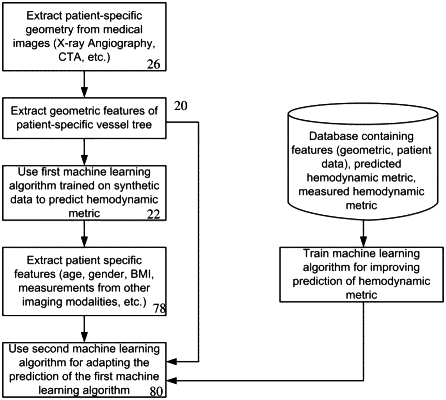| CPC A61B 6/5217 (2013.01) [A61B 5/026 (2013.01); A61B 5/7267 (2013.01); A61B 6/032 (2013.01); A61B 6/504 (2013.01); A61B 6/507 (2013.01); A61B 8/06 (2013.01); A61B 8/065 (2013.01); A61B 8/5223 (2013.01); G06F 18/217 (2023.01); G06F 18/22 (2023.01); G06F 18/2413 (2023.01); G06T 7/0012 (2013.01); G06T 7/11 (2017.01); G06V 10/42 (2022.01); G06V 10/776 (2022.01); G16H 20/00 (2018.01); G16H 30/40 (2018.01); G16H 50/20 (2018.01); G16H 50/50 (2018.01); A61B 5/02007 (2013.01); A61B 5/02028 (2013.01); A61B 5/0263 (2013.01); A61B 5/743 (2013.01); A61B 6/469 (2013.01); A61B 8/469 (2013.01); A61B 2576/00 (2013.01); G06T 2200/04 (2013.01); G06T 2207/10072 (2013.01); G06T 2207/10076 (2013.01); G06T 2207/20081 (2013.01); G06T 2207/30101 (2013.01); G06T 2207/30104 (2013.01); G16H 30/20 (2018.01)] | 17 Claims |

|
1. A method for plaque determination in medical imaging, the method comprising:
acquiring medical scan data representing an anatomical structure of a patient;
extracting a set of features from the medical scan data;
inputting, by a processor, the features to a first machine-trained classifier, the first machine-trained classifier trained to output a value of hemodynamic metric;
inputting the value of the hemodynamic metric and additional features to a second machine-trained classifier; and
outputting, by the processor with application of the first machine-trained classifier to the features, an indicator of a risk of the plaque rupture or a nature of the plaque, the indicator being a function of the value of the hemodynamic metric and being a future evolution of the patient, the future evolution of the patient based on machine training with patient evolution data, the second machine-trained classifier performing the outputting of the indicator in response to the inputting to the second machine-trained classifier.
|